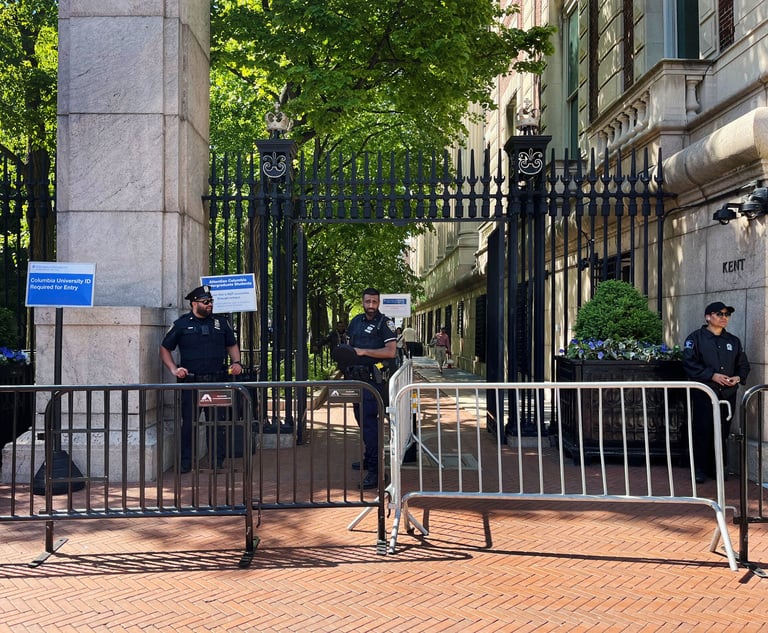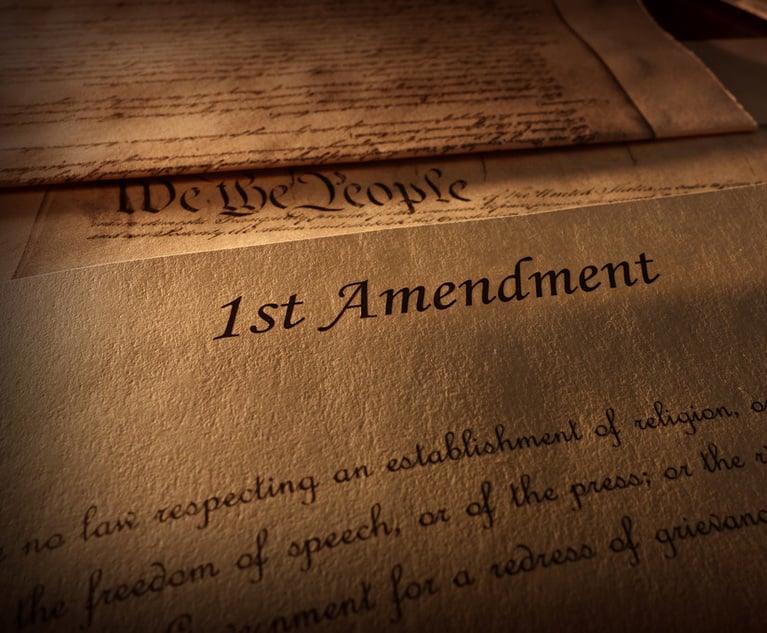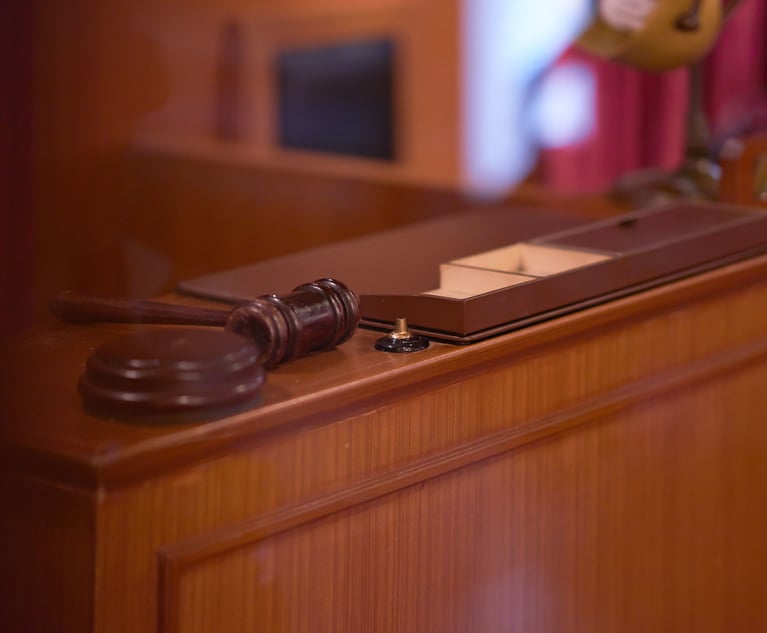Ahead of the Curve: Fixing the U.S. News Rankings
This week's Ahead of the Curve looks at a proposed overhaul of the U.S. News World Report law school rankings that would emphasize issues that are important to students, such as affordability.
May 21, 2019 at 12:40 PM
10 minute read
Welcome back to Ahead of the Curve. I'm Karen Sloan, legal education editor at Law.com, and I'll be your host for this weekly look at innovation and notable developments in legal education.
I'm happy to be back after a week off, and I'm diving right in with a look at recent University of Pennsylvania law grad Christopher Iacono's new look at the U.S. News law school rankings and how they can be improved. Next up, I'm asking readers to weigh in on how Law.com reports on the ABA's annual law school employment figures. Read on!
A Critique of U.S News Rankings (Again)
That people have problems with the U.S News & World Report law school rankings is hardly news. Law deans love to complain about the negative effects of the annual list and how it skews priorities (while also playing along in the game.) Heck, there was entire book written about it in 2016. All of which is to say that I wasn't immediately interested in a new critique of the rankings produced as an independent study project by University of Pennsylvania student Christopher Iacono, who just graduated today. But then I got to thinking that I haven't yet seen a law student tackle this topic—it's usually professors and deans and other researchers who tend to broach it. So I decided to take a look at Iacono's paper titled: Legally Unhappy: How US News and Law Schools have failed and How This Can Be Fixed, which he hopes to publish in a law review. It's an interesting read, but before I delve into its content I want to share a bit about the author, who is an untraditional student to say the least.
Iacono works full-time as a police officer in Philadelphia, and has done so the entire three years of law school—attending classes by day and patrolling by night—at a top law school, no less. That alone I find pretty impressive. Oh, and he also works as a clerk at personal injury firm Kline & Specter. I caught up with Iacono recently to talk about his paper and how he used the U.S. News rankings in his own decision making. Here's what he told me:
“I put a lot of weight on it. I felt like I needed to go to the best school in order to give myself the best job opportunities coming out. For me, it was a toss-up between Penn and Temple. Temple is ranked lower than Penn. Temple is lot cheaper than Penn. Temple has a part-time program, where it would have been a lot less stressful on my life. At the end of the day, I would have been the same Chris going to Temple as the Chris at Penn. But I was willing to fork out an extra $100,000 and crush my body for three years, probably because of the rankings. If it weren't for the rankings, I would have gone to Temple. It would have been a no brainer.”
That's a pretty convincing argument for the deep influence U.S. News has on the law school admissions scene and how applicants choose schools. Iacono started looking into the rankings at the suggestion of his independent study advisor Shanin Specter and initially focused on the existing research and writing about the rankings. But he wanted to go deeper and eventually interviewed about 30 professors, deans, and former deans about them. Plenty of people didn't want to talk about it—he asked about 200 people for interviews. But a few were surprisingly candid about the ways that they goosed their numbers to appear higher in the rankings and how much they took the rankings into account when making decisions. A former dean from a top school told Iacono that his school would “massage” numbers that were open to interpretation, such as counting part-time professors as full-time faculty in order to improve the student-to-faculty ratio. The former dean of a mid-tier law schools spoke of the well-documented transfer phenomenon—in which schools accept a large number of second-year transfer students whose lower LSAT scores would have hurt their rankings had they been admitted as 1Ls.
So how to fix this apparent mess? Iacono has a few ideas, some of which I like more than others. His overarching aim is to realign the rankings according to what matters most to students: long-term career satisfaction, the quality of the educational experience and teaching, and overall value. For instance, Iacono proposes that a revamped rankings formula should reward schools with lower tuitions. That makes sense in theory, though his suggested path to lower tuition is for schools to reduce their full-time (and expensive) faculty members in favor of adjuncts, which is a controversial idea, to put it mildly.
I can see issues with incorporating student evaluations and long-term career satisfaction surveys into the rankings as well, given their subjective nature. One of the reasons U.S. News applies so much weight to LSAT scores and undergraduate grade-point averages is that they are pretty straightforward numbers that are standardized across the board, at least as far as the LSAT. I'm not sure that the credibility of the ranking is necessarily improved once you add in a number of other subjective categories.
I don't see the rankings getting an overhaul of this degree anytime soon, but I think it's a useful experiment to think through what the rankings would look like if they were redesigned with the needs of students at the forefront. And I'm impressed with the legwork Iacono put in to gauge how legal academics view the benefits and flaws of the rankings.
The takeaway: At the end of our conversation, I asked Iacono what advice he would give prospective law students, knowing how the U.S. News sausage gets made. His answer was telling: “I'm still torn by it. On the one hand, I have a much more accurate view of what they are. I think they are flawed. At the same time, if I knew what I knew now when I was applying to schools I would unequivocally go to Penn because of the rank. As flawed as I think it is, it's just a reality that's there. If you are applying for jobs and you're a graduate of Harvard, Penn, Stanford or Yale, you're going to have more opportunities. It's just the way it is. You can't turn a blind eye to it.”
 |
|Counting Law Grad Jobs
One of the things I like about having this weekly briefing is that I can give readers some behind-the-scenes glimpses into covering law schools. I'm going a little further this week to ask for feedback on how Law.com presents employment data from the ABA.
Here's the quick backstory: Each year when the ABA releases its trove of graduate employment data I break the numbers down into a series of charts showing how schools perform relative to each other in different categories such as full-time legal employment, federal clerkships, and unemployment rates. (You can check out this year's edition here.) I think of it as a useful tool for prospective law students given that sorting through the ABA's website is cumbersome.
Last year, at the suggestion of a few career services folks, I added a category that showed the percentage of recent graduates in jobs at law firms of 100 or more lawyers or recent grads in federal clerkships. The two categories—“large” firm jobs and federal clerkships—were combined under the “elite jobs” heading. Their argument was that presenting those two categories of highly sought after jobs would give a fuller picture of which schools have the most robust career outcomes. For instance, Columbia is always tops in law firm jobs, but is lower on the list when it comes to federal clerkships. Yale kills it on the clerkship market, but doesn't tend to send as many students into large firms. Virginia isn't in the top three of either category, but lands at No. 1 when you combine them.
Shortly after this year's list came out, University of California, Berkeley School of Law dean Erwin Chemerinsky emailed me to raise an objection to the inclusion of that “elite” category on the grounds that it sends the message that government and public interest jobs are less desirable or prestigious than large firm jobs and clerkships. He rightly pointed out that a spot in the Justice Department's Honors Program or a gig with the ACLU are highly competitive and sought after. Apparently quite a few people on a listserv just for law deans agreed with his concerns about our inclusion of this “elite” jobs category. (Alas, I couldn't follow the debate myself as I'm not on that listserv, as much as I would love to be!) Chemerinsky raised three specific points with me:
➤➤ That large firm jobs and federal clerkships should not be referred to as “elite”.
➤➤ That we shouldn't be grouping those jobs together in the first place.
➤➤ That if we do have a chart showing the schools with the most graduates in highly sought-after jobs, government and public service jobs should be included in the metric.
After mulling this over for more than a week, I think Chemerinsky is right that calling federal clerkships and large firms jobs “elite” is not the right language. If we opt to report this metric again, I'll simply call it large firm jobs and federal clerkships. But I'm not convinced that government and public interest jobs belong in that metric. My concern is that the government and public interest jobs category spans a wide range of employment situations. Some, like the DOJ Honors program, certainly are elite. But not all are on that level, and I'm uncomfortable with the addition of such a broad swath of jobs to two other categories that are relatively specific. Another way to say it is that I'm not convinced that adding together the ABA's federal clerkships, large firm jobs, and government and public interest jobs produces a helpful figure.
Here's where I'm undecided: Should Law.com drop that combined federal clerkships and large firm metric altogether? Is it useful? Does it send a message that government and public interest jobs aren't good jobs? (We do have a separate chart showing which schools send the most graduates into those positions.) I'd love to hear thoughts from readers on this. You can email me at [email protected]
Thanks for reading Ahead of the Curve. Sign up for the newsletter and check out past issues here.
I'll be back next week with more news and updates on the future of legal education. Until then, keep in touch at [email protected]
This content has been archived. It is available through our partners, LexisNexis® and Bloomberg Law.
To view this content, please continue to their sites.
Not a Lexis Subscriber?
Subscribe Now
Not a Bloomberg Law Subscriber?
Subscribe Now
NOT FOR REPRINT
© 2025 ALM Global, LLC, All Rights Reserved. Request academic re-use from www.copyright.com. All other uses, submit a request to [email protected]. For more information visit Asset & Logo Licensing.
You Might Like
View All



Trending Stories
- 1Judicial Conference Declines Democratic Request to Refer Justice Thomas to DOJ
- 2People in the News—Jan. 2, 2025—Eastburn and Gray, Klehr Harrison
- 3Deal Watch: Latham, Paul Weiss, Debevoise Land on Year-End Big Deals. Plus, Mixed Messages for 2025 M&A
- 4Bathroom Recording Leads to Lawyer's Disbarment: Disciplinary Roundup
- 5Conn. Supreme Court: Workers' Comp Insurance Cancellations Must Be Unambiguous
Who Got The Work
Michael G. Bongiorno, Andrew Scott Dulberg and Elizabeth E. Driscoll from Wilmer Cutler Pickering Hale and Dorr have stepped in to represent Symbotic Inc., an A.I.-enabled technology platform that focuses on increasing supply chain efficiency, and other defendants in a pending shareholder derivative lawsuit. The case, filed Oct. 2 in Massachusetts District Court by the Brown Law Firm on behalf of Stephen Austen, accuses certain officers and directors of misleading investors in regard to Symbotic's potential for margin growth by failing to disclose that the company was not equipped to timely deploy its systems or manage expenses through project delays. The case, assigned to U.S. District Judge Nathaniel M. Gorton, is 1:24-cv-12522, Austen v. Cohen et al.
Who Got The Work
Edmund Polubinski and Marie Killmond of Davis Polk & Wardwell have entered appearances for data platform software development company MongoDB and other defendants in a pending shareholder derivative lawsuit. The action, filed Oct. 7 in New York Southern District Court by the Brown Law Firm, accuses the company's directors and/or officers of falsely expressing confidence in the company’s restructuring of its sales incentive plan and downplaying the severity of decreases in its upfront commitments. The case is 1:24-cv-07594, Roy v. Ittycheria et al.
Who Got The Work
Amy O. Bruchs and Kurt F. Ellison of Michael Best & Friedrich have entered appearances for Epic Systems Corp. in a pending employment discrimination lawsuit. The suit was filed Sept. 7 in Wisconsin Western District Court by Levine Eisberner LLC and Siri & Glimstad on behalf of a project manager who claims that he was wrongfully terminated after applying for a religious exemption to the defendant's COVID-19 vaccine mandate. The case, assigned to U.S. Magistrate Judge Anita Marie Boor, is 3:24-cv-00630, Secker, Nathan v. Epic Systems Corporation.
Who Got The Work
David X. Sullivan, Thomas J. Finn and Gregory A. Hall from McCarter & English have entered appearances for Sunrun Installation Services in a pending civil rights lawsuit. The complaint was filed Sept. 4 in Connecticut District Court by attorney Robert M. Berke on behalf of former employee George Edward Steins, who was arrested and charged with employing an unregistered home improvement salesperson. The complaint alleges that had Sunrun informed the Connecticut Department of Consumer Protection that the plaintiff's employment had ended in 2017 and that he no longer held Sunrun's home improvement contractor license, he would not have been hit with charges, which were dismissed in May 2024. The case, assigned to U.S. District Judge Jeffrey A. Meyer, is 3:24-cv-01423, Steins v. Sunrun, Inc. et al.
Who Got The Work
Greenberg Traurig shareholder Joshua L. Raskin has entered an appearance for boohoo.com UK Ltd. in a pending patent infringement lawsuit. The suit, filed Sept. 3 in Texas Eastern District Court by Rozier Hardt McDonough on behalf of Alto Dynamics, asserts five patents related to an online shopping platform. The case, assigned to U.S. District Judge Rodney Gilstrap, is 2:24-cv-00719, Alto Dynamics, LLC v. boohoo.com UK Limited.
Featured Firms
Law Offices of Gary Martin Hays & Associates, P.C.
(470) 294-1674
Law Offices of Mark E. Salomone
(857) 444-6468
Smith & Hassler
(713) 739-1250









